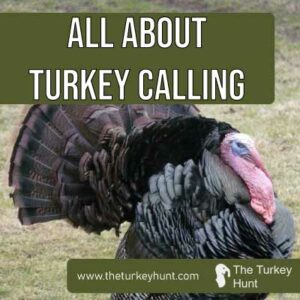When turkey hunting, there are many different things to keep in mind while waiting for that massive, beard dragging Tom to come your way. One of the things you have to become proficient at is known as turkey calling. What does calling for turkeys do? What’s the most realistic call? How often should you call for a turkey?
These are some of the common questions we’ll go over in this turkey calling guide. After all, if you can’t call for a turkey properly, you probably won’t have a successful hunt.
Turkey Calling – Why Do It?
While it is technically possible to find a roost, and sit somewhere near by, and pray the turkeys come your way, this is not the best approach to turkey hunting. What you need to do is learn to call for turkeys properly.
You do this in order to cause a sense of curiosity for either a Tom or Hen. Turkey calling is one of many different ways to lure in your turkey, so you can nail that beard dragger.
What Does Calling for Turkeys Accomplish?
Calling for turkeys accomplishes one major thing: drawing in the flock.
If you can call successfully, you’ll be able to draw in your turkey within shooting distance. The rest is up to you and how good of a shot you are.
Different turkey calls mean different things to the birds. Let’s cover some of the psychology behind turkey calling, and what it means to the turkeys.
What Are the Different Turkey Calls and What Do They Mean?
There are a ton of different calls, and depending on who you ask these might have different names. I went ahead and made a list of the common names of the turkey calls, and what they mean. Read below:
- Yelps – Mainly a locator call for breeding. Hens will use this to locate other birds and let them know they are ready for breeding.
- Clucks (Putts) – Used to locate other birds.
- The Purr – There are conflicting thoughts here. Some claim it is made when a turkey is content, others claim it is made to let other birds know that they are in another bird’s territory.
- Gobbling – Mating call of the male turkey. Widely recognized.
- Cutting – Typically made when a Hen needs a companion.
If you have all of these down, you will increase your chances of a successful turkey hunt dramatically. Keep in mind that different types of turkeys may call in slightly different ways, so be sure to have all of these calls perfected.
1. Yelp
You should make sure to nail down a solid yelp turkey call. They are useful for many different scenarios, and aren’t too hard to pull off – regardless of the type of call you prefer. Realistic yelps will undoubtedly draw in massive Toms.
2. Cluck
Clucking is a simple hen call. Beginners should learn this call first, however, they will continue to use the cluck call for their entire hunting career. When all else fails, you can cluck call to mimic a lost bird trying to find their way back to other birds.
3. Purr
Purring is something not everyone can mimic. It’s not easy, but once you can purr realistically, you have added a very useful turkey call to your toolkit. This is more of a difficult call to learn, but still worth practicing until you nail it.
4. Turkey Gobble
Everyone knows what a gobble is – even non hunters. Heck, one of the first animal noises most kids learn is a turkey gobble. There is nothing quite like an early morning in the spring season hearing the gobbles echo through the landscape. If you know, you know.
A well done turkey gobble can actually draw in nice sized Toms that are looking to protect their territory from other Toms. Only Toms will gobble.
5. Cutting
Cutting comes in many different variations. While not too hard to learn, you need to be able to cut in the proper way. It’s a very versatile call that will benefit you greatly to learn.
How Do You Call a Turkey?
Related: How to Call a Turkey
This is entire separate post in itself, but calling a turkey all comes down to mimicking the right sound at the right time. If you can do this, you will end up drawing your bird in. Learning how to call in a turkey is an art in itself, and it takes some people a lifetime to perfect all of the different types of calls we discussed earlier.
You can use different types of calls to accomplish this task. Some people prefer the mouth call over a slate, while others really enjoy a box call. Whatever you feel most comfortable with, and are best with, is what you should choose.
The goal here is to sound as realistic as possible. Practice as much as you need to, but when it comes time for the hunt you should use what you can mimic a turkey with most effectively.
How Often Should You Call a Turkey?
This is one of the hardest parts about calling. If you call too often, you will spook the birds away. If you don’t call often enough, the birds will never come.
That said, most hunters agree that you should call a turkey in about every 15-20minutes. You are more likely to over call a bird, than under call it. When in doubt, always wait longer before you start calling again.
What’s the Most Realistic Turkey Call?
Hunters who are best with a mouth call can usually pull off the most realistic turkey call. This is also, probably, the most difficult of all the calls. Mouth calls require constant practice, but can create some of the most realistic bird calls you can imagine.
Turkey calling done correctly with a mouth call can match a bird’s calling. Have you ever heard stories about hunters being in the same area, and calling each other but not realizing it? This is almost always done with mouth calls.
Where Can I Buy Turkey Calls?
Related: Where to Buy Turkey Calls
You can buy turkey calls online, or at most hunting/outfitting stores. If you are looking to purchase one, consider going through The Turkey Hunt for some of the best deals on the best turkey calls on the market. We review everything we buy, and only sell calls that are sure to increase your chances at a successful hunt.
Slate Calls
Slate calls are circular disc-like tools that come with what looks like a stick that you can rub on the slate to create different sounds. These calls can come with either a slate, or glass top on them. Glass and slate make different sounds, depending on how you use them. Some prefer glass, others prefer slate.
Beginners will find these incredibly useful, and they can sound very realistic once you get the hang of how to use them.
Box Calls
Box calls can replicate some calls extremally well. Users just need to rub the top, or lid, of the box call back and fourth with a bit of finesse to replicate the call they are going for.
The downside is they are somewhat bulky, and require two hands to use. You need to be ready to drop your call and shift to your shotgun or bow if a bird moves in unexpectedly.
Mouth Calls
Mouth calls are preferred by most competent hunters. Mouth calls look like a tiny horse shoe that has some thin latex (reed). It fits in the roof of your mouth and you can make different turkey calls by how you shift your tongue on the mouth call.
The major benefits of these turkey mouth calls is that they require no hands to use, so you can always have your weapon at the ready while simultaneously calling the bird. You can also create a louder sound than with the other calls.
Electronic Turkey Calls
These types of calls require batteries, and are actually not allowed in some states. Be sure to triple check your state hunting laws before using one while calling for turkeys.
The biggest benefit of using these is that they are as close to a real turkey call as possible – because they are a recording of an actual turkey.
What are Good Beginner Turkey Calls?
While beginners can technically start with whatever they feel most comfortable with, a beginner mouth call or box call will suit most new hunters best. Look for mouth calls that are V cut, with three reeds. The more complex the latex cut, the harder the mouth call is to learn. However, with a more complex cut comes a more realistic sound.
Beginners need to focus on yelping and clucking. If you get great at these, you are on the right path, and can have a successful turkey hunt.
Summary – Turkey Calling
As you can see, there is a LOT that goes into turkey calling, and the different types of turkey calls that exist.
Generally speaking, you need to know what type of a call to use at what time. Do you cluck, cut, or yelp? When?
It all depends on what the birds in your area are doing at the time you’re out hunting. You can buy man made calls all over the place, but consider purchasing through some of the sponsors of The Turkey Hunt. We make a small commission on all sales, and only offer great quality calls that you’ll love.

